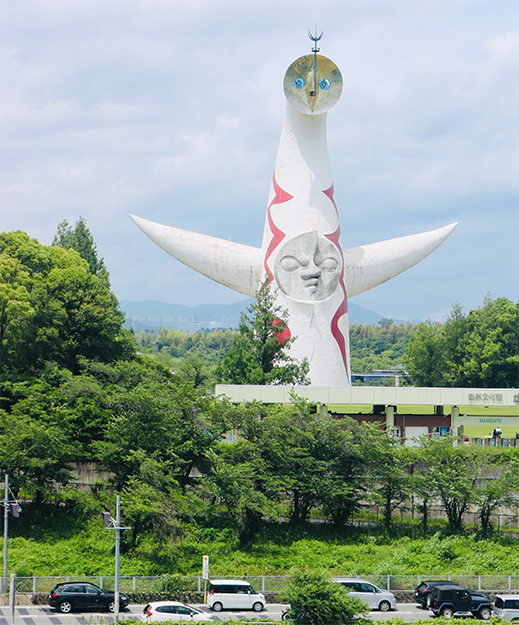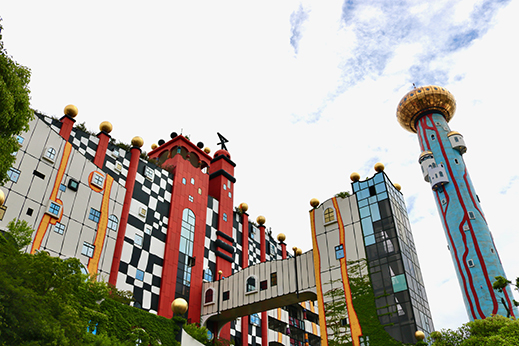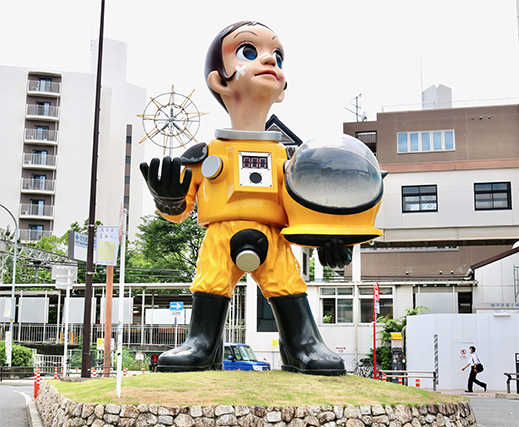 |
Focus features two in-depth reviews each month of fine art, architecture, and design exhibitions at art museums, galleries, and alternative spaces around Japan. |
|
|
 |
 |
 |
Art in the Great Outdoors: Osaka's Modernist Monuments
Colin Smith |
 |
Roy Lichtenstein's Osaka Vicki (1997-8) adapts one of his super-sized comic panels to a cooling tower near Shinsaibashi. Photo by Colin Smith |
Entering the second half of 2020, as things gradually reopen we are acclimating to new realities. At art venues, as of this writing these include some measures that can feel like improvements over life "B.C.," like restrictions on crowding, and others that do not, like limiting admission to residents of a certain prefecture. But whether in times of crisis or not, there are works of public art we can enjoy without entering a venue at all. While attending exhibitions remains more onerous than it was, now's the time to take a fresh look around at art we may be taking for granted.
Osaka is Japan's second smallest and second most densely populated prefecture, after Kagawa and Tokyo respectively. Like Kyoto and Kobe, the other cities in the Keihanshin conurbation, Osaka City has a distinct identity, and people pride themselves on a unique culture and long history predating that of Tokyo or even Kyoto. That culture tends to be more on the "low" (pop, street, vernacular) side than the "high," and appreciation for modern and contemporary art could be said to lag -- though things are looking up with a new modern art museum (the Nakanoshima Museum of Art, Osaka) scheduled to open next year after nearly 40 years on the drawing board. Also, there are several monumental public works of modern and contemporary art and architecture that reflect a quintessentially Osakan vitality.
|
 |
|
|
|
Taro Okamoto's Tower of the Sun (1970), seen here through the window of the Osaka Monorail, epitomized the optimism of postwar boom times and remains a heartening symbol for locals. Photo by Tomomi Saeki
|
The most famous is the 70-meter-high Tower of the Sun (1970) by Taro Okamoto (1911-96), located in Expo '70 Commemorative Park, Suita City in the north of the prefecture. Its official website describes the neo-primitivist colossus as "a symbol representing the energies of all things in the universe . . . the center of life and the center of matsuri (festivals)." It has three faces (one on the back), red streaks of lightning on the front, "green solar corona waves" on the reverse, and appendages raised triumphantly -- echoing another symbol of Osaka's vigor, the neon Glico "running man" next to the Dotonbori canal. Built for Expo '70 Osaka, the tower was subsequently opened to the public, featuring exhibits such as the 41-meter Tree of Life illustrating the evolution of organisms. Today the interior (known as the Tower of the Sun Museum) can be entered with tickets reserved on the website (admission is temporarily suspended due to COVID-19). Of course the exterior can always be seen in the park, or while passing by on the Osaka Monorail or Chugoku Expressway.
Right next to another highway, but in a blind spot for drivers -- perhaps luckily so, since the eye-catching artwork made police wary of its potentially causing accidents -- is one of the largest, and last, works of the American Pop artist Roy Lichtenstein (1923-97), Osaka Vicki (1997-8). Thirty-seven meters high and 15 meters wide, the Benday-dot painting of a blonde woman and a back-turned man just opening a door is a reworking of the artist's Vicki! I -- I Thought I Heard Your Voice! (1964), with framing elements added and dimensions altered to fit the side of a cooling tower for the then-new underground shopping mall Crysta Nagahori. It is on the south side of Nagahori-dori Ave., one of Osaka City's main arteries, a few blocks west of Shinsaibashi Station on the northern edge of the youth-oriented America-Mura district. The mall's environmental designer, Takeshi Fukuda, told the Asahi Shimbun newspaper that they needed something that symbolized America while also livening up the bland, windowless cooling tower. Isamu Suzuki, in charge of its maintenance for many years, said people often describe the brash, primary-colored composition as "just like Osaka."
 |
|
 |
|
Architecture as art: two of Osaka's most beautiful and inspiring buildings, the Maishima Incineration Plant (1997-2000) and Maishima Sludge Center (2000-4) by Friedensreich Hundertwasser. Photos by Tomomi Saeki |
Visible from the Hanshin Expressway and several other highways are two works of visionary architecture amid the drab industrial sprawl on an artificial island in Osaka Bay: Maishima Incineration Plant (1997-2000) and Maishima Sludge Center (2000-4), designed by Friedensreich Hundertwasser (1928-2000). The larger Incineration Plant has all the elements of the Austrian architect's singular style and ethos: avoidance of straight lines (which he called "godless and immoral"), brilliant colors and fairytale ornamentation (including numerous windows, most purely decorative, and over 100 large golden spheres), trees and greenery not only around the building and on its rooftop but also growing out of windows, and an emphasis on the environment (the plant is partially powered by the garbage it vaporizes). The proposal for these projects came just when Osaka was unsuccessfully bidding for the 2008 Olympics, for which the island was constructed, and the time was ripe for a fantastical showpiece in the often all-too-pragmatic city. Tours by reservation of both the Incineration Plant and the Sludge Center, and open-house days at the former (all currently suspended due to the coronavirus -- see website, in Japanese only, for updates), let visitors inside Hundertwasser's architecture to see what becomes of rubbish. The buildings can be seen from afar from various locations, but viewing the sublime details requires a pilgrimage by car, or by bus from JR Nishikujo Station. Adults with children in tow can also get inside a Hundertwasser structure at Kids Plaza Osaka (which has now reopened with precautions), where he designed the Kids Town play zone on the Adventure floor with his signature curves, uneven floors, and brilliant tiles and mosaics.
 |
|
Kenji Yanobe's Sun Child (2011) outside Minami-Ibaraki Station memorializes the Tohoku earthquake, tsunami and nuclear disaster. Photo by Colin Smith |
Near Tower of the Sun is another sun-themed sculpture. Kenji Yanobe (b. 1965) grew up nearby and has described playing amid the "ruins of the future," after Expo '70 (theme: "Progress and Harmony for Mankind") was dismantled, as a formative experience. One of three versions of his Sun Child (2011) stands in the center of a roundabout in front of Minami-Ibaraki Station on the Hankyu Kyoto Line or the Osaka Monorail two stops from Expo '70 Commemorative Park. The six-meter-high boy stands heroically in a yellow radiation suit, a stylized sun balanced on one hand, a protective helmet (removed since it is now safe to breathe) on the other, crossed bandages on one cheek (battered but unbowed), large hopeful eyes turned northeast toward Tohoku. He was installed on 11 March 2012, the one-year anniversary of the earthquake, tsunami and nuclear disaster in that region. His female counterpart, Sun Sister, stands by the water behind the Hyogo Prefectural Museum of Art in Kobe, commemorating the 1995 earthquake there, while another Sun Child had an all-too-short residence in Fukushima Prefecture (see "Hidden Gems: Public Art in Hyogo Prefecture" by Christopher Stephens in the 15 May 2020 Focus). Hankyu Railway says there are no plans to remove Sun Child from the artist's home turf.
Yanobe's lifelong drive to explore the ruins of the future led him to do a project in Chernobyl, and his many works related to radioactivity contain serious yet optimistic messages along with large doses of edgy humor. His massive fire-belching Lucky Dragon (2009), mounted on a boat that plied the waterways of Osaka, commemorated the irradiation of the fishing boat Daigo Fukuryu Maru ("Lucky Dragon No. 5") -- an incident that inspired the original 1954 Godzilla, whose protagonist Yanobe's dragon resembles. It also celebrated Osaka's aquatic spaces, once thriving corridors of industry and commerce, more recently moribund but now undergoing a revival. Another giant mobile waterborne work, Dutch artist Florentijn Hofman's popular Rubber Duck, has made repeated visits to Osaka. While enjoying the urban great outdoors, keep an eye on the water as well as the streets for art that may appear where you least expect it.
 |
 |
Colin Smith
Colin Smith is a translator and writer and a long-term resident of Osaka. His published writing includes the travel guide Getting Around Kyoto and Nara (Tuttle, 2015), and his translations, primarily on Japanese art, have appeared in From Postwar to Postmodern: Art in Japan 1945-1989: Primary Documents (MoMA Primary Documents, 2012) and many museum and gallery publications in Japan. |
|
 |
|